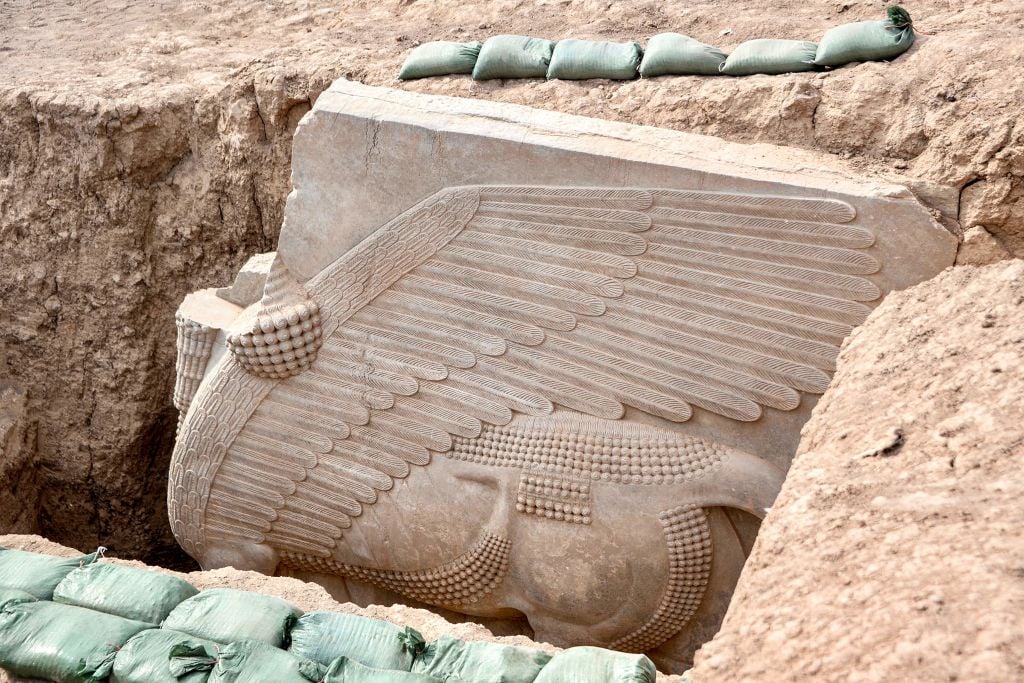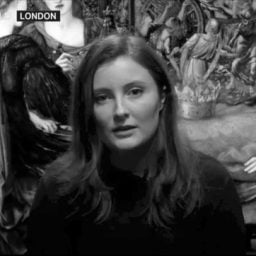A remarkably well-preserved 2,700-year-old Assyrian Lamassu, an ancient deity in the shape of a winged bull with a human head, has been unearthed by archaeologists at Khorsabad in northern Iraq, once the Assyrian capital of Dur-Sharrukin. What makes the 18-ton, 12.5-foot-tall alabaster sculpture unusual is that it was first uncovered more than a century ago, but was intentionally reburied for nearly three decades to keep it safe from looting and conflict above ground.
“I never unearthed anything this big in my life before,” one of the dig’s leaders Pascal Butterlin told AFP. “Normally, it’s only in Egypt or Cambodia that you find pieces this big.”
The piece has both its wings intact but the head is missing. Luckily, this final piece is held by the Iraqi National Museum in Baghdad and these two parts will shortly be reunited.
The earliest record of the complete Lamassu dates back some 150 years, when it was documented by the French archaeologist Victor Place. However, it was only officially excavated by Iraq authorities in 1992 and shortly afterwards, in 1995, it fell pray to thieves who removed the head and broke it into pieces so that it could be smuggled out of the country. Thankfully, this attempt was thwarted by customs authorities and the head was transferred to the Iraqi National Museum. There, it has also managed to survive a break-in and a looting spree that took place in 2003, shortly after the U.S. invaded Iraq.
The body, meanwhile, was reburied in the 1990s as a short-term solution to ensure its protection. A decade later, the body was also lucky to escape the campaign of destruction against cultural heritage in the country that was carried out by ISIS in 2014. This is thanks to the efforts of locals in concealing its underground location. Due to a lack of funding and political turmoil in the region, the body has only just been recovered.
“It was a multidimensional archaeology,” Butterlin told Hyperallergic. “It’s the archaeology of conflicts and urban archaeology, and the lamassu is just at the border of both — with multiple lives.”
The team that re-excavated the Lamassu’s body was led by Butterlin, who is a professor of Middle Eastern archaeology at the Sorbonne, and Iraq’s minister of culture Ahmed Fakak Al-Badrani. Lammasus were deities with human heads and the body of a lion or bull and were usually positioned at the entrances of royal palaces in Assyria. This example was commissioned for the King Sargon II during the eighth century B.C.E. and was installed at the gates of the city of Khorsabad, which he had built, for its protection.
More Trending Stories:
News Icon Barbara Walters’s $8 Million Estate Hits the Block at Bonhams, With Her ‘Audacious’ Jewelry Taking Center Stage
There’s Much More to Caravaggio’s ‘The Cardsharps’ Than Vice. Here Are Three Facts That Offer a New Perspective on His Early Masterpiece
Here’s Your Guide to the Priciest and Most Sought-After Artworks for Sale During New York’s $2 Billion Fall Auction Season
Revealed: The Major Mystery Consignors of New York’s Multi-Billion-Dollar Fall Auction Season
A Secret Room in a 16th-Century Italian Chapel, Where Michelangelo Hid—and Drew—for Months, Opens to the Public
Christie’s Pulled Two Works by a Prominent Middle Eastern Artist From Sale After a Complaint
A Nautical Chart Sold at Auction for $239,000 Is Revealed as the 4th Oldest of Its Kind and Is Now Tagged at $7.5 Million






